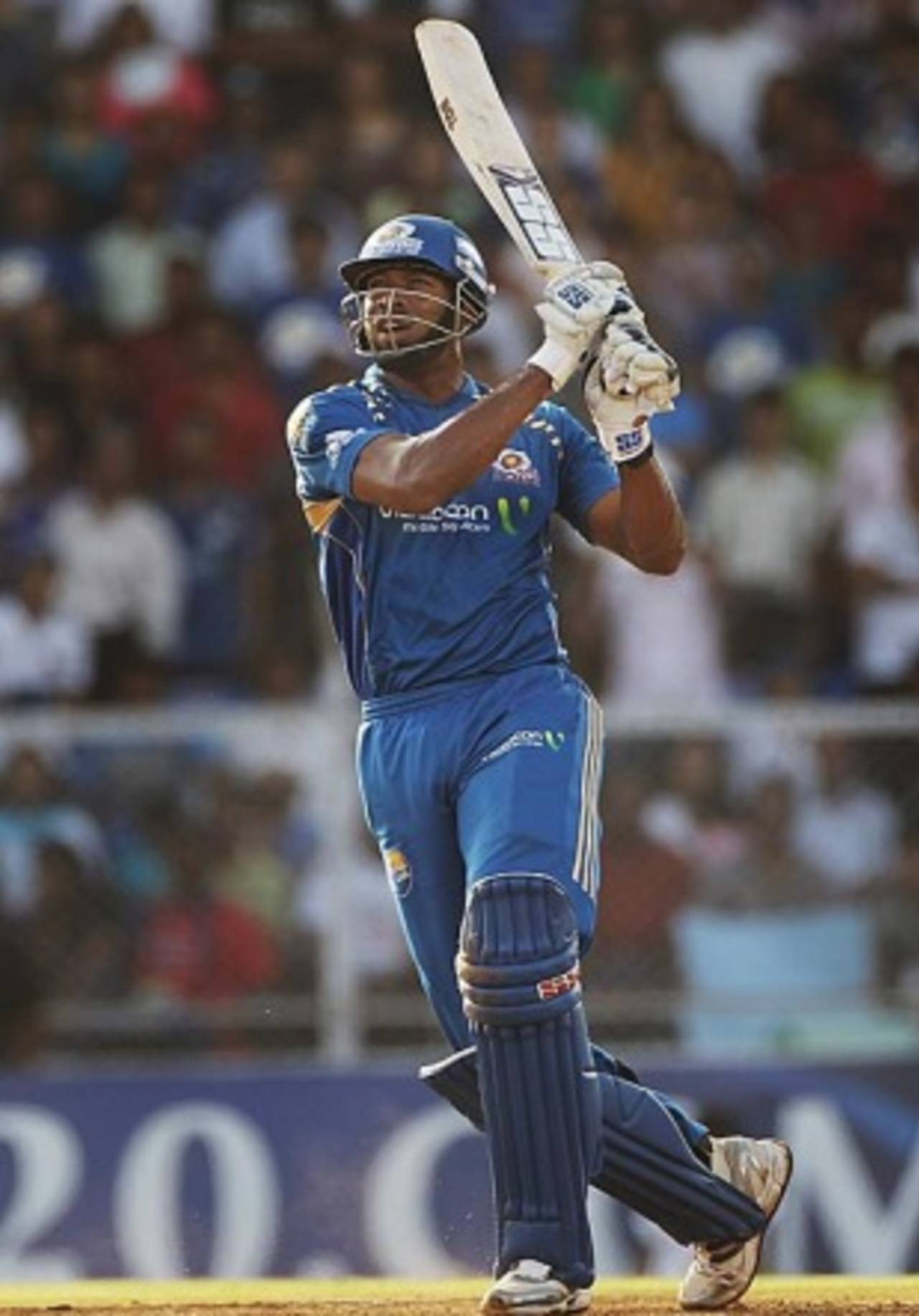The IPL XI
Now that the IPL is done and dusted, Cricinfo picks its IPL XI, and it's a Chennai-Mumbai-Bangalore oligopoly

Kieron Pollard was destructive with the bat, effective with the ball, and lively in the field • Indian Premier League
1 Jacques Kallis (Bangalore)
Stats: 572 runs, 115.78 strike-rate; 13 wickets, economy-rate 8.35.Best performance: 89 off 55 balls v Punjab.
Key role: Kallis was consistent and aggressive in the first half of the season. He was unbeaten until his fifth innings and played a crucial role in Bangalore's four-match winning streak. His ability to bowl the heavy bouncer helped Bangalore target batsmen with short deliveries on the quick Chinnaswamy pitch.
2 Sachin Tendulkar (Mumbai)
Stats: 618 runs, 132.61 strike rate.Best performance: 89 off 59 balls v Rajasthan.
Key role: Tendulkar's isn't the first name on the team sheet only because he doesn't take strike. His calming consistency while opening the innings helped Mumbai become the first semi-finalist and top the league stage. He did not have to change his approach to score the most runs in the season, and at one stage had a strike-rate of 155.75 after four matches despite not having hit a single six.
3 Suresh Raina (Chennai)
Stats: 520 runs, 142.85 strike-rate, 6 wickets, economy-rate 7.46Best performance: 83 off 52 balls v Mumbai
Key role: In IPLs past, Raina had the luxury of coming in after Matthew Hayden had given Chennai a powerful start. Not this time. Hayden's miserable form meant Raina had to shoulder much of the burden, and he did. His fielding was among the best in the IPL, he was the Man of the Final, and a strong contender for the Player of the Tournament.
4 Ambati Rayudu (Mumbai)
Stats: 356 runs, 144.71 strike-rateBest performance: 55 off 29 balls v Deccan
Key role: Rayudu was the best of the former ICL players and played a vital role in the middle order. He provided a seamless link between Tendulkar's strong starts and Pollard's brutal finishes and could revive the innings when needed as well. Rayudu's not a wicketkeeper but he performed the role competently in the interests of team balance.
5 MS Dhoni (capt & wk) (Chennai)
Stats: 287 runs, 136.66 strike-rateBest performance: 54 off 29 balls v Punjab
Key role: Dhoni was average with the bat until Chennai couldn't afford it anymore. In a must-win game against Punjab, he pulled off an improbable chase with the most brutal hitting Dharamsala is likely to see. He contributed on a difficult pitch to ease Chennai through the semi-final and kickstarted the acceleration in the final too. No other wicketkeeper came close to surpassing his form, and few captains matched his leadership skills either.
6 Robin Uthappa (Bangalore)
Stats: 374 runs, strike-rate 171.55Best performance: 51 off 21 balls v Punjab
Key role: Cries of "Hodiyo, hodiyo, Uthappa" (Hit it, hit it, Uthappa) rang round the Chinnaswamy when Robin Uthappa strode out busily to bat. He was Bangalore's game-changer, tearing into the bowling attack at pivotal moments, and finished the tournament's highest six-hitter, with 27.
7 Kieron Pollard (Mumbai)
Stats: 273 runs, strike-rate 185.71; 15 wickets, economy-rate 7.40Best performance: 33 off 13 balls and 3 for 17 v Bangalore, first semi-final
Key role: Pollard is a near-perfect Twenty20 cricketer. Mumbai relied on him to boost totals by 30-odd runs in the last two overs of the innings, and Pollard delivered strike rates of 200-plus often. His medium-pace bowling fetched wickets and he covered ground faster than most with his long strides on the boundary line and between the wickets.

8 R Ashwin (Chennai)
Stats: 13 wickets, economy-rate 6.10Best performance: 3 for 17 v Kolkata
Key role: His ability to bowl with discipline with the new ball, during the fielding restrictions, was instrumental in Chennai's resurgence in the latter half of the league. Ashwin gave his team the perfect start to their defence of 168 in the final - bowling a maiden over to Shikhar Dhawan.
9 Anil Kumble (Bangalore)
Stats: 17 wickets, economy-rate 6.42Best performance: 4 for 16 v Deccan, third place playoff
Key role: Kumble bowled himself in tough situations, during the Powerplay and in the last six overs, and exercised control on the run rate, conceding fewer than six an over during these periods. His performance in the third-place match was crucial in Bangalore securing a berth in the Champions League Twenty20.
10 Lasith Malinga (Mumbai)
Stats: 15 wickets, economy-rate 7.02Best performance: 2 for 22 v Rajasthan
Key role: Malinga was a death bowler par excellence, unleashing a flurry of accurate yorkers towards the end of an innings. In the Mumbai-Rajasthan match, where over 400 runs were scored, Malinga was the only bowler to concede fewer than six an over.
11 Doug Bollinger
Stats: 12 wickets in eight games, economy-rate 6.67Best performance: 4 for 13 v Deccan, second semi-final
Key role: The turnaround in Chennai's campaign, which saw them rise from No. 6 and 7 to champions, was largely due to Bollinger - his bluster and his exceptional left-arm seam bowling. Before he joined the side, Chennai didn't have a new-ball attack worth mentioning, and after he arrived, they needed to win most of their games to reach the semis. In his first match, against Rajasthan, Bollinger took 2 for 15 and caught Yusuf Pathan superbly on the boundary. The revival had begun.